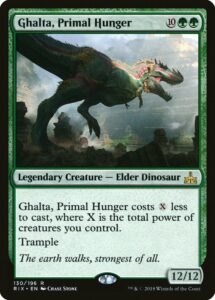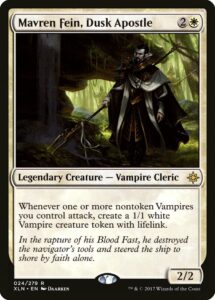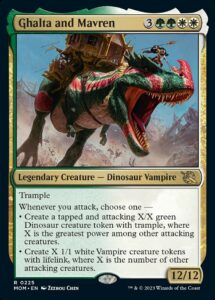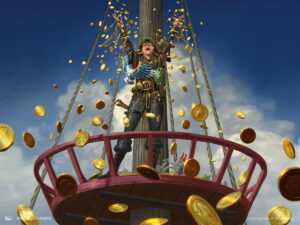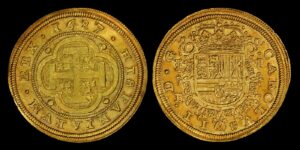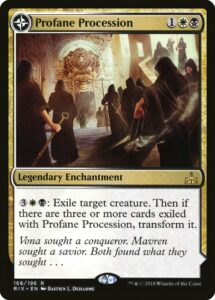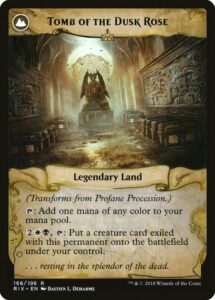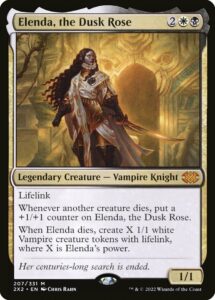After more than two decades of playing Magic: The Gathering, it’s hard for the game to shock me. Multiversal apocalypse? I’ve been through my share. Beloved characters die? I’d seen Bambi and read Where the Red Fern Grows by age ten.
Even so, the March of the Machine previews debuted at MagicCon Philadelphia left me with my mouth open. Well, one preview in particular.
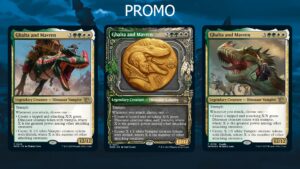
Image by Wizards of the Coast
No, not the Zezhou Chen art on the left or the Betty Jiang art on the right, though both are awesome in their own ways. My eyes went straight to the alternate-frame art in the middle.
First thought: That’s a well-illustrated medal.
Second thought: That’s a very well-illustrated medal. Who did that?
Third thought: Jody Clark? They got Jody Clark?!
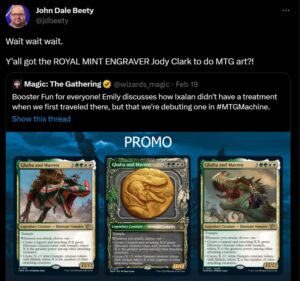
So What’s the Big Deal?
For many new Magic illustrators, debuting with the game is a breakthrough moment for their art careers.
Jody Clark’s artwork has been reproduced literally billions of times already.
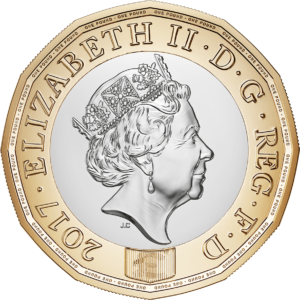
Image by The Royal Mint
In 2015, Jody Clark, then a relatively new employee of The Royal Mint, was announced as the winner of a contest to design a new portrait of Queen Elizabeth II for British coinage. He was only 33 years old, the youngest artist in memory to do such a portrait for the United Kingdom.
After several more years with The Royal Mint and additional designs put into production, including a new coinage portrait for Australia, Jody Clark joined the private sector in May 2020. He made his Magic illustration debut with 2022’s Dominaria United.
Wait, He’s Not a New Magic Artist?
While Jody Clark’s most famous works are numismatic designs for coins, medals, and related objects, that isn’t his only mode of art-making. Because the process of bringing a coin design into reality goes through stages of two-dimensional concept drawing (traditional or digital) and three-dimensional low-relief sculpture (traditional or computer-aided), this sets up a coin designer well for commissions in those media and related ones. And on seeing Stained Glass Strangle, aka Brazillian [sic] Jiu Jitsu Is My Religion, it’s easy to draw a throughline between that work and the four stained-glass-style illustrations of his Magic debut.
When I found Jody Clark’s name on these illustrations after a search, I felt silly. I’m supposed to be on top of new Magic artists, so how did I miss the connection to an artist I already knew from being a former professional coin geek? The only excuse I can offer is that “Jody Clark” is a relatively anonymous name — there’s at least one other artist named Jody Clark out there — and I was not familiar with the coin-famous Jody Clark’s other work.
Once I saw the medal, though, I knew. It combines the best qualities of the illustrations for Saga cards, which depict art forms the inhabitants of a Magic setting would make, and Secret Lair, which sometimes brings in artists with specialist skills. Jody Clark’s years of experience at making numismatic designs, plus his hard-won knowledge of how those specific three-dimensional objects appear in two dimensions, give Ghalta and Mavren that further nuance of rendition a connoisseur recognizes instantly, though may find hard to articulate.
Analyzing the Artwork: Context
In analyzing any fantasy artwork, there’s a risk of going too deep and draining all the wonder out of it. To a broad extent, the Rule of Cool prevails, and pedants who try to poke holes swiftly wear out their welcomes. On the other hand, it’s precisely because a bona fide numismatic design expert created Ghalta and Mavren that the work can stand up to intense scrutiny and give reliable insights into its fantasy world.
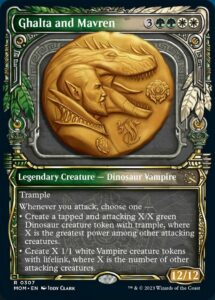
To start, the setting for the artwork is the plane (fictional world) of Ixalan. Its largest continent, also named Ixalan, mixes inspirations from Mesoamerica (think Mayan-style jade), the Golden Age of Piracy, and the lost world literary subgenre, with conquistador vampires from the other sizable continent, Torrezon, thrown into the mix. It’s a lot.
In response to an invasion by a different plane (one of many simultaneous invasions by a prominent villainous group), two unlikely allies team up: Torrezon’s vampiric cleric Mavren Fein and Ixalan’s long-hidden massive dinosaur Ghalta.
Unlike the action-oriented illustrations of this team-up at the top of the article, Jody Clark’s depiction is static, clearly not “of the moment.” We’ll return to this clue soon.
Analyzing the Artwork: Formal Qualities
“Formal“, in this art sense, means a work’s physical qualities, the “what” rather than the “why” behind it. The following analysis covers the object depicted within the Jody Clark illustration, rather than the illustration itself.
The object is most likely a table medal or small plaque; the line between them can be thin. It’s roughly round in shape, though with irregular borders. The central design, a jugate of Mavren Fein in front and Ghalta behind, is in relief, projecting from the field or background. The degree of relief tells against the object being a coin, as the portraits are so high and unprotected — there is no rim on the object, unlike on most modern coins — that they would wear away rapidly as they circulated in commerce. Comparing the object with coins depicted in Ixalan’s setting, as on Revel in Riches, or real-world coins from colonialist Spain shows the difference right away.
- Revel in Riches, illustrated by Eric Deschamps
- 1687 Spanish eight escudos coin, from the National Numismatic Collection, National Museum of American History at the Smithsonian Institution
Because we only have access to the object through an illustration, there are certain formal qualities we can only guess at. The yellow surface material is most likely metal, but whether that’s gold or a bright copper-based alloy such as brass or orichalcum bronze is unknowable, as is whether it’s solid or some sort of plating or coating. Similarly unknowable is whether the object was created by striking in a press, casting, or some other technique. (It’s a fantasy world; we can’t rule out magic!)
Analyzing the Work: Embedded Meanings
The object originates from Torrezon. It reads as European-influenced, not Mesoamerican, and the pirate-exiles of Ixalan would honor neither Mavren nor Ghalta. Its irregular edges may refer to macuquinas or “cob” coins, made using older technology and not perfectly round, or to the Torrezon-perceived “wildness” of Ixalan (Ixalan’s Sun Empire and River Heralds would disagree). The medals made for the 2002 Winter Olympics in Salt Lake City, shaped like Utah river rocks, are a potential real-world analogue for the latter explanation.
“The Making of the 2002 Olympic Medals,” by O.C. Tanner
The two roses, a small one worn by Mavren and a larger one in the field to the right of Ghalta, are deeply symbolic. A rose is the emblem of Saint Elenda of Garrano, also known as Elenda, the Dusk Rose, first of the Torrezon vampires and a key figure of their faith. The rose near Ghalta implies that the massive dinosaur has become an instrument to serve their church. Whatever the facts, that is the message sent, and few have better qualifications to send it than the designer of the heraldry-celebrating “Queen’s Beasts” series of coins.
Certain elements, however, remain inscrutable. What is below Ghalta’s mouth? It looks like some sort of Torrezonian script, but guesses at its meaning (Mavren’s name, “battle”, “Ixalan”, etc.) must remain guesses for now.
Analyzing the Work: How and Why It Exists
An intentionally crafted object implies at least one maker and reason, a how and a why. The Ghalta and Mavren object is no exception.
In the context of Torrezon, “maker” most likely means one or more artisans, plus a commissioner who could afford to have it made. This could be someone well-placed in government (Torrezon is a monarchy) or the church, possibly even the hierophant Mavren himself. This last possibility, of course, assumes that Mavren still exists. While the object reads plainly as honoring Mavren, without further information, its purpose could range from Mavren’s expression of his own deeds and power to another’s tribute to his memory. The similarities in two portraits of Arthur Wellesley, 1st Duke of Wellington, one made in 1841 while he still lived and another to commemorate his death in 1852, show the danger in jumping to conclusions.
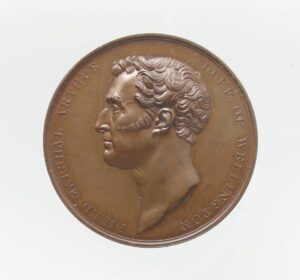
Benedetto Pistrucci medal Duke of Wellington, 1841, Met Museum collection
Two points, however, seem indisputable: enough of Torrezon survived to produce the object, and the allied efforts of Ghalta and Mavren were worth celebrating. For players currently stuck in a narrative moment where all seems lost, it’s a sign of hope.
A Culmination and a Beginning
On several levels, Jody Clark’s illustration of Ghalta and Mavren is remarkable. The successes of Sagas and Secret Lair created a supportive environment for the medal-as-game-art concept. A specialist of great distinction at the height of his powers took on the assignment. He then delivered an illustration deeply rooted in both his own practice and the fictional world, giving detail after detail for fans to appreciate and clue after clue for them to discover.
I don’t know what’s next for Jody Clark and his work for Magic. All I can hope for are new illustrations, especially numismatic ones (bring on the Treasure tokens!), as I wait for the chance to put a counter he designed, aka a recent British coin, on my copy of Ghalta and Mavren.
John Dale Beety (he/him) explores the edges of gaming fandom through work, as a copy editor for a games retailer, and play, as a freelance writer of fantasy lore. His latest acquisition for his cabinet of curiosities is a Brokers desk seal from New Capenna. Due to an incident aired on national television, he holds a lifelong grudge against long-dead department store magnate Rowland Hussey Macy.


